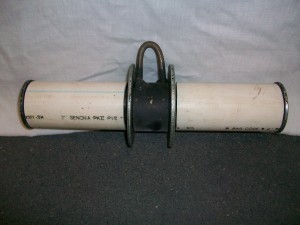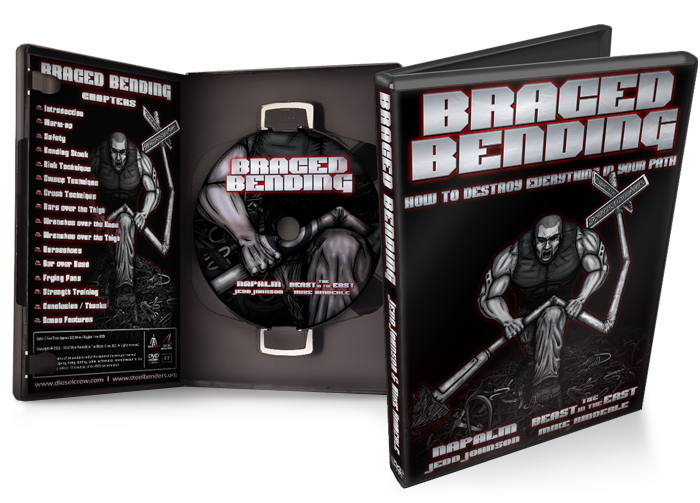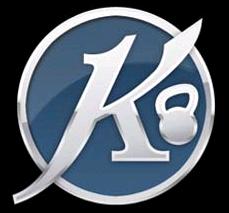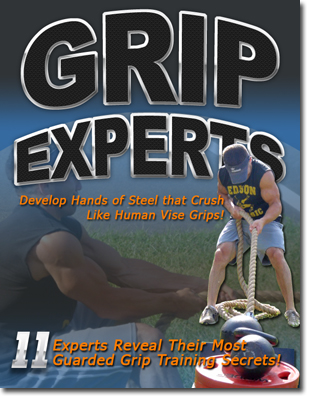Friday, November 02, 2012
Simple, Effective, and Cheap Bullet Proofing
Thursday, November 01, 2012
9 Tips on Injury Prevention
Wednesday, October 31, 2012
Building the Better Mousetrap
Tuesday, October 30, 2012
What is the Modular Grip System?
Sunday, October 28, 2012
Tough Kettlebell Grip Shit
I’ve said for years that Grip Training is one of the
most important types of training that most people
are NOT doing.
A Strong Grip helps you perform better in sports
by being able to hold onto the ball, bat, or your
opponent better.
A Strong Grip also helps you improve your
numbers on lifts where the hands are involved,
especially the all important Bench Press. By
having a firm grasp on the bar, it helps you engage
your upper body in the lift much better while also
increasing your confidence in the lift, knowing
you are going to dominate it with no problem.
Finally, Strong Hands and Forearms are Safer
Hands and Forearms.
What I mean by that is when you have put in the
work to strengthen everything from the elbow
down in a balanced fashion, it makes you much
more injury-resistent. You are able to take more
bumps without having to worry about breaking
something and you’re able to give more bumps
without having to hold back.
The issue with all this is, how do you get started?
People make Grip Training out to be a lot tougher
than it is. In fact, if you have a small kettlebell in
the 15- to 30-lb range, you’ve got exactly what
you need in order to start training your grip and
start reaping all the benefits.
Kettlebell Gut Pops (Full Hand Emphasis)
Forget the fact that the kettlebell has a perfectly
good handle on it. Instead, pick it up by the belly
or Gut. Next, pop it up into the air and try to grab
it with the other hand.

In the pictures above, I am using a 30-lb Kettlebell.
However, take note that I am not as much of a
bad-ass as I may seem THIS TIME, because this
kettlebell has a rubber coating around it. If you have
one that is bare iron it is going to be much tougher.
Kettlebell Front Raise (Thumb Emphasis)
Again, Grip the Kettlebell by its round gut with an
open hand. Next raise it up in front of you like a
front delt raise, making sure to keep the thumb
positioned on the bottom of the bell in order to
hit it the hardest way possible.

If you are a true tough guy, try holding it up for a
pause on each repetition.
Kettlebell Horn Deviations (Wrist Emphasis)
Grip the Kettlebell this time by the “horn,” which
is the part of the handle that is generally vertical.
From there, lower the bell down into ulnar
deviation and then back up into radial deviation.

If you love the pain and torture of this variation,
you should also try supinating and pronating the
forearm. LOVELY!
There are thee Grip Training movements you can
start doing RIGHT NOW in your routine to get the
benefits of stronger lower arms and hands.
If you want more ideas on how to be a bad-ass by
lifting crazy shit and bending and tearing everything
in site, check out The Grip Authority. I’ll tell you how
to build the strength to be able to rip phone books,
tear cards and bend steel.
Now, go Lift or Destroy something.
All the best in your training.
Jedd Johnson, CSCS, RKC
Captain of Crush | Red Nail Certified
See more on building ridiculous hand strength = > http://www.thegripauthority.com
Friday, October 26, 2012
Kettebell Swing + Grip Training Benefits
You want information on
Here is an article on a device called
(1) The increased size of the handle,
and
(2) The dynamic nature of the training.
1. The Increased Size of the Handle
The "handles" we often train on are barbells
Plus, dumbbells and barbells are almost
With Kettlebells, however, the handles are
Now, let's look at the other side of the equation...
Kettlebell Exercises, especially Cleans, Snatches
Add in the fact that sets generally include between
So, the handles are larger and slicker, which will
So everybody should go get a set of Kettlebells, right?
Well, while I do think Kettlebells are awesome pieces
They can get quite expensive.
Kettlebells can be picked up ranging from 12 pounds
Well, I want to tell you about an innovation

The Napalm's Nightmare device combines
These two traits of the Napalm's Nightmare
Here is the best picture I could find, which I

Plus, at the bottom of the swing, when it passes
So, obviously, I am either a genius for innovating
Either way, if you use one of these, your hands,
Unfortunately, I don't sell these implements.
BUT, I do show you exactly how you can make
In fact, not only do I show you how the
If Grip Strength is something you need to
Home Made Strength II will help you expand
For more information and to find out exactly
All the best in your training,
Jedd
P.S. This video comes in a Digital Streaming
Thursday, September 27, 2012
Grip Strength Program
Would it be a novice, advanced, expert, or world class?
I'm thinking it's in-between novice & advanced for the 8 week program."
Ben, thanks for writing in. Like I said, this is a question
By the way, if you haven't signed up for my newsletter
and gotten this free program, you can do so here.
It is probably best to label this a "Training Layout"
I say this, because when I designed it, I wanted to put
There may indeed be lifts or challenges in this layout
This is not to make you feel weak or anything like that.
When I first started out with Grip I was NO WHERE
Believe me, I have been at this a long time, and if it
The total truth is that I had trouble filming all of the
So as you go through the program, if you are unable
What I would suggest is to print out the PDF and
At least that is the goal...
Once you work your way through all 8 weeks and all
You will also know what you need to work on as far
Most of all, this program is meant to be fun. That is
Feel free to substitute things if you don't have the
If you don't have a 45-lb Block Weight to use, feel
I also do consultations for setting up Grip Programs,
And finally, don't forget about my coaching site,
At TGA, the members of the site are able to view
One of the most popular features is my monthly
Again, I hope you are having fun with the 8 Week
Thanks again for signing up and let me know if you
All the best in your training,
Jedd
Wednesday, September 26, 2012
"MikeIn the DVD you talked a little about 180degrees being a legally bent shoe but I wascurious if there are other rules when itcomes to bending. I know you said thewraps have to pass through a 1.25 inch holebut are there any rules on how muchpadding you can use? I would assume youcan not use anything hard. I saw you usinga piece of foam padding on top of a towelin a couple of your vids and was curiousabout that as well?Jason"
Wednesday, July 04, 2012
The Forearm Pain Paradox
paradox - A statement or situation which defies logic or reason
Today I am going to tell you about the Forearm Pain Paradox.
Imagine being able to bend spikes and steel bars with your hand and wrist strength, but not being able to turn a door knob to pen a door.
Imagine being able to lift a world record weight in a strength contest, but not being able to straight your arms to do so.
Finally, imagine being dog-tired from one of the best workouts you ever had, but not being able to fall asleep because your forearm hurts so bad you can't find a pain-free position.
All of these scenarios are things I have lived with over the years.
My name is Jedd Johnson, and I am from DieselCrew.com. I am a strength coach, and my passion is Grip Strength. I love bending nails, tearing cards and phone books and own world records in grip.
But I am also just like you. I know what it is like to have workouts hindered due to the annoying nagging pain that can happen up around the top of the forearm and elbow.
Chances are, if you have been training hard for a while, or if you do a lot of hand-intensive manual labor, you have had bouts of forearm pain like this too.
Maybe, you're even suffering from it right now.
Forearm pain, especially up near the elbow, creates what I call the Forearm Pain Paradox. What I mean is, you can have strong hands and wrists, and lower arms capabable of absolutely astonishing feats of strength and power, but your grip goes completely to shit when you have high forearm and elbow pain, especially medial and lateral epicondylitis. There are so many attachments in that small area near your elbow, if something goes wrong, it's like the strength you've worked to build up for years works against you.
The same goes for big movements, like bench press, overhead press, squats and deads. You can be a damn monster in the weight room, but if you get high forearm or elbow pain bad enough, you can kiss PR's goodbye...
Forearm pain SUCKS, and thousands of people get it each year. In my estimation, I have had what is referred to as medial and lateral epicondylitis, and more commonly known as Golfer's Elbow and Tennis Elbow, respectively, about 10 times since 2003.
The Causes of Forearm Injuries
I know a lot of you love getting into the meat and potatoes behind all of this stuff, so here it is in a nutshell.
Medial Epicondylits (ME) - Golfer's Elbow

M.E. is an injury to the common flexor tendon which originates from the medial epicondyle, a bony structure high on the elbow, and on the underside. That just means a lot of the flexor muscles start there. It also means that if you do a lot of movements where you are flexing your hands and wrists, you could end up with this problem. This is also caused by a valgus movements, where the forearm moves out away from the body, but the upper arm stays close to the body, like the back arm of the golf swing, which is why it's called Golfer's Elbow.
Lateral Epicondylitis (LE) - Tennis Elbow
L.E. is nearly the same as M.E., but the difference is that it takes place in the common extensors tendon, which is on the back of the forearm, and attaches on the top part of the elbow. This one is caused by rotation and extension movements. Even just straightening the arm can lead to it, so you don't need to rip, bend and tear things to cause issues. Just the basic pressing movements can do it. Tennis players get this because of the drag that takes place when swinging the racket in a back-hand strike.
What Can You Do about These Conditions?
Now that you know what these conditions are with their supped-up names and bad attitudes, it's time to discuss what to do about these conditions.
First and foremost, preventing these conditions is a lot more fun than getting them. Like I said, I have had both of these full-blown conditions about ten times over the years, from 2003 until 2009.
In 2003, I was bending steel and lifting stones like a mad man, but when it came to turning a door knob, my knees would buckly because of the pain. Several times, the pain was enough to keep me awake at night, and my most recent case of full-blown LE, the injury was so bad, that I needed to wear elbow sleeves with tiny heating packets in them in order to keep the area warm enough to straighten my arm to pick up weights from the floor.
In 2009, I decided I'd had enough of this crap, so once I rehabbed it that last time, I began implementing a battery of preventive exercises. I still do all of my feats and compete in Grip Sport contests, but now, I am smarter about it.
Surprisingly, the Preventive measures add almost no time to my training at all. They are so simple, I often wonder why I didn't start doing this stuff way back in 2003.
The principles I use involve promoting strength in the extensor muscles, which open the hand. This keeps a strength balance between the extensor muscles which open the hand and the flexor muscles which close the hand, and keeps the lateral epicondyle and the tendons that connect to it in good working shape.
Other things like a good warm-up and keeping the area warm during my training (also known as common sense) have paid huge dividends in my training, allowing me to train longer, miss fewer workouts, and compete at a higher level.
So, I have become very good on the Preventive side. In fact, I wanted to put together an ebook to help others prevent these types of injuries from occurring at the forearm and elbow, but I soon realized that it would be a complete waste of time for many people, because so many people are already bother by this kind of intense pain.
That was when I knew I had to track down somebody that was experienced at rehabbing this kind of injury. That was when I tracked down Rick Kaselj. Rick has many certifications behind is name, but that is not what is important. What really matters is the fact that he has already helped so many people in the past get through injuries.
I contacted Rick about putting together something with me for forearm injuries like this and he agreed. Within a short time, we had developed the main outline of Fixing Forearm Pain - Medial and Lateral Elbow Pain Fix for Athletes and Lifters.
Rick and I released this new product this week, and we know that there are a lot of you out there who are struggling with forearm pain. That is why we opened it up for this week at such a dirt cheap price - $19. That is less than my co-pay when I go to the doctor!
If you've had forearm/elbow pain for a while, you know how bad it can affect your training, strength levels, attitude, and night-time rest. Grab our ebook and study Rick's portion, where he outlines his professional approach to rehabbing elbow pain
And maybe you've never had pain like this, but you know that the training you do could one day cause something down the road. In that case, check out the manual and dive into my section, where I talk about the Preventive Methods I have used for the last couple years to keep high forearm and elbow pain from coming back.
I know this manual is going to help a lot of people, so make sure to get it before Friday, because then the price is going to increase.
All the best in your training,
Jedd
P.S. Don't be the "I'll wait to later" guy. You and I both know that later never comes, and if it does, it might be too late to grab
Monday, July 02, 2012
Got Wrist Pain?
Sunday, July 01, 2012
Grip Training: Benefits of Sledgehammer Training
Thursday, June 07, 2012
Creating Tension to Increase Strength
Saturday, May 19, 2012
Nothing is Going to Stop Me
program where I work with fewer people, but have more
personal contact, I am all about helping people attain their
goals.
whether it is for Grip Strength or some other aspect of the
Iron Game, you've got to have the right Mindset.
yourself.
pick up a certain Grip Strength challenge item, or do some
other awesome feat, you can't have any doubts that you
will get it.
"NOTHING is going to stop me."
right before he went for a lift, say something like, "Man I
don't know if I can lift this."
kind of sh*t used to pi** me off big time!
BEAST.
the gazelles? Those savage, crazed BEASTS will run
around the savannah chasing after prey for hours until
they tackle one.
the pack would die off, and the Lion race would go extinct.
Lion in the grasslands chasing down their prey.
out loud every time you lift (although I am enjoying doing
just that these days) but you do need to approach each set in
the right way.
I can do this" enter your mind, stop it right away and think
of something else to replace it.
before I go after a lift. In the past, I have even used,
"New Record in December, Baby!"
every time you are about to hit a lift and you will see
improvement.
to stop me from reaching my goals" type of mentality,
before you go for something HUGE, "I came here to kick ass
and chew bubble gum, and I am all out of bubble gum, like
Rowdy Roddy Piper in the movie, Them."
Whatever gets you in the right frame of mind - like the Lion
on the prairie hunting down those tasty gazelles.
can be when I was shooting Road to the Record. I was training
for the Two Hands Pinch world record and I kept saying, over
and over - "New Record in December Baby!"
Tuesday, January 24, 2012
New DVD: Braced Bending
Mike Rinderle and I have released our second project together, called, Braced Bending: How to Detroy Everything in Your Path.
In this one, we cover techniques for bending not only various lengths of steel, but also wrenches, horseshoes, hammers, and even how to roll frying pans.
So check this thing out today. Braced Bending DVD
I want to hear about the damage YOU can cause.
All the best in your training,
Jedd




















